Welcome to the best information on the twelve Best Qualitative Data Analysis Software available. Using qualitative data is absolutely crucial in the competitive environment of today to improve business plans. After looking over several choices, we discovered among the most adaptable, user-friendly, and potent qualitative data analysis tools. Dive in to investigate:
- Sentiment analysis AI-powered solutions
- Easy dashboards for real-time data visualizing
- Modern text-mining tools for ideas rich in substance
From startups to established businesses, every company—from interviews to open-ended question responses to social media feeds—deserves for effective methods to sort through unstructured data. Learning qualitative data helps companies to better grasp their target markets, make decisions with knowledge, and create ideas never seen before.
Remember to also visit Plerdy, a multifunctional utility for Conversion Rate Optimization & User Experience. Plerdy puts your data analysis to life, therefore improving user involvement and enabling CRO initiatives to be actionable. Start right now to boost your game in qualitative data analysis!
What is Qualitative Data Analysis Software?
Deciphering difficult human behaviors, motives, and attitudes requires first a foundation in qualitative data analysis. Unlike its quantitative equivalent, which explores numerical data, qualitative analysis concentrates on analyzing non-numerical data including written documents, focus groups, and interviews. Professionals in disciplines ranging from market research to social sciences to healthcare employ this method to acquire detailed understanding.
Here’s the reason qualitative data analysis excels:
- Context-rich interpretation: Reveals the “why” underlying decisions, behavior, or trends. A consumer survey, for example, can explain client loyalties going beyond basic percentages.
- Nuanced Insights: Dives into the complexity of human behavior provide nuanced insights that are valuable in psychology and anthropology to help to understand the interactions of several society elements.
- Flexibility: Makes it essential for erratic, dynamic environments like political campaigns since it allows one to adjust to new factors or conditions during a research.
Although raw data—such as field notes or transcriptions—may seem random at first—software programs meant for qualitative data analysis are the cornerstone in order to simplify this mess. Before combining data into useful insight, these tools provide strong capabilities that enable you to classify, code, and annotate data. In scholarly study, for instance, software might sort through years of past materials to identify repeating themes. In the business world, the same instruments can examine consumer comments to spot developing trends before they become widely used.
Investing in qualitative data analysis tools helps you to equip yourself with a strong toolkit that transforms your analysis from basic interpretations to rich, practical insights. Data scientists, business owners, and researchers all benefit from qualitative analysis tools in developing interesting stories from challenging data environments.
The Importance of Using Specialized Software for Qualitative Data Analysis
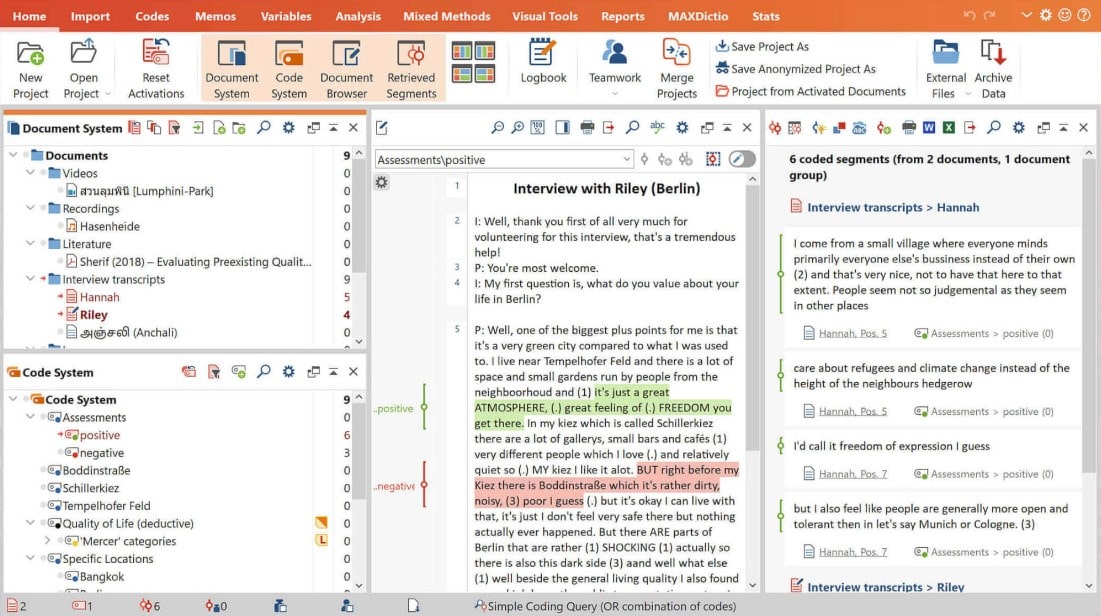
In qualitative data analysis, specific software are absolutely necessary rather than only a nice-to-have. Using modern software tools will enable your research from basic to revolutionary leap forward. Imagine yourself carefully examining difficult social encounters or sorting through thousands of customer interviews. Manual work not only slows you down but also raises your chance of missing insightful analysis. Software simplifies the procedure and offers your study efficiency, accuracy, and a whole fresh perspective.
The following explains why you cannot afford to overlook specific tools for qualitative data analysis:
- Data Organization: Software tools tag, organize, and classify your data to help you locate what you need, when you need it.
- Collaborative Utility: Team members can work simultaneously, sharing codes, notes, and observations in real-time.
- Advanced Analytics: From semantic networks to sentiment analysis, advanced analytics—from semantic networks to sentiment analysis—that manual approaches just cannot match.
- Data Visualization: Create mind maps, charts, or graphs that crystallize difficult concepts into readily consumed images.
In the medical area, for instance, specialist software provides a whole picture of patient experience that transcends simple statistics and helps researchers investigate the psychological elements of chronic diseases. These instruments can sort consumer reviews and social media buzz in market research to find brand perceptions, therefore guiding corporate plans. Software enables academics in education to examine years of instructional strategies, therefore influencing future curricula with data-based insights.
Basically, qualitative data analysis software is your secret to complex insights. It provides the bandwidth you need to examine vast amounts of data and identify ideas that might inspire innovation and transformation.
List of Best 12 Qualitative Data Analysis Software
There might be terrifying complexity in the array of qualitative data analysis techniques. But our carefully chosen list of the “12 Best Qualitative Data Analysis Software” is your North Star; it shows a straight road out of the sea of possibilities. Equipped with modern capabilities ranging from sentiment decoding to text-mining complexity, every software on our list promises to be the cornerstone in your qualitative data analysis toolset.
Plerdy Software
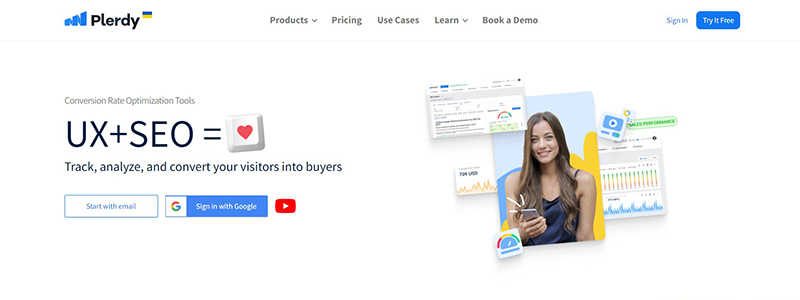
If you’re negotiating the maze of data analysis tools, you most likely came upon Plerdy. This software is a powerhouse meant to increase your qualitative data analysis, not only another dot on the radar. Acting as a multifarious platform, Plerdy aggregates heatmaps, SEO checkers, and user behavior analytics to create a 360-degree image of your data scene.
Plerdy distinguishes herself in the packed field by:
- Comprehensive Heatmaps: Analyze clicks, mouse movement, and scrolls in complete heatmaps. Find areas of user engagement that cause discomfort; then, adjust your website.
- In-depth SEO Analysis: To guarantee best site performance, track keyword rankings, check meta descriptions, and analyze your backlink profile in-depth.
- User Behavior Insights: Analyze the visitor path from entrance to exit to gain understanding of user behavior. Decode the behavior causing drop-off or conversion.
- Dynamic Filters: Change your data graphics using dynamic filters. Zero in on particular metrics from device type to user location to target your most pertinent KPIs.
Consider an e-commerce business that must grasp consumer behavior for several product lines. By simplifying the complexity of clicks, scrolls, and hovers into usable data, Plerdy helps the business to match its product placements, descriptions, and the checkout procedure. Another instance is a digital marketing agency breaking apart client website performance to find user interaction bottlenecks and SEO mistakes that conventional data analysis would ignore. By doing this, Plerdy is the pillar helping to create exactly targeted data-driven marketing plans.
In negotiating the complex field of qualitative data analysis, Plerdy is a lighthouse of accuracy and efficiency. Its strong characteristics not only simplify data collecting but also boost the analysis stage, thereby offering you both broad and detailed insights. Look no further then if you’re looking for a software platform that improves your qualitative data analysis. Plerdy has you covered and provides a complete toolkit to transform data complexity into interesting, practical stories.
NVivo Software
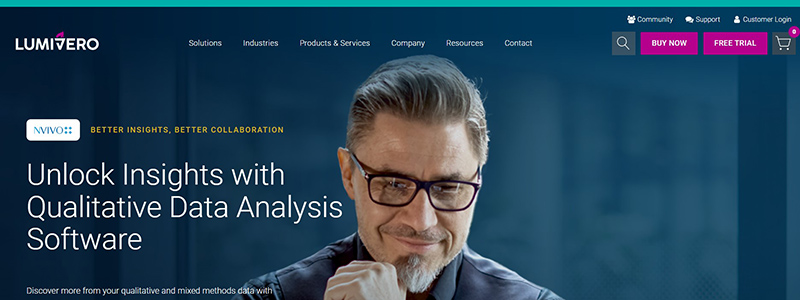
NVivo shines in the galaxy of qualitative data analysis instruments like a supernova. Designed especially for those who wish to delve deeply into unstructured or semi-structured data, this software provides a suite of software that turn data into decisions. Whether you’re working on market trends, healthcare projects, or social science research, NVivo sharpens your analysis by getting right to the brass tkes.
Important Characteristics Setting NVivo Apart:
- Thematic Analysis: Classify and arrange your data according to recurrent trends; this will help sociologists analyzing cultural events.
- Sentiment Analysis: Analyze the emotional undertone of text-based data. Perfect for market researchers looking to uncover brand sentiment by means of consumer reviews.
- Data Import Flexibility: Pull data under one roof from several sources—such as interviews, social media, and scholarly publications.
- Visual Data Modeling: For business consultants developing detailed strategies for clients, visual data modeling—turn difficult datasets into easily readable charts or diagrams—is indispensable.
Assume for the moment that you are a public health researcher exploring the effects of telehealth services. NVivo lets you combine linked academic papers, medical interviews, and patient questionnaires. Run a theme analysis to identify important success elements or obstacles; then, graph them in visually striking models. The result is You now have sophisticated ideas that might affect hospital administrative practices or future healthcare policy.
Not only does NVivo have better analytical skills, but also how those skills are combined into an easy-to-use interface that speeds your process. NVivo releases you to concentrate on producing strong insights that have a real impact by doing the onerous data organization and analysis chores. All things considered, NVivo is more than simply software; it’s an end-to- end qualitative data analysis tool that precisely moves you from inquiry to conclusion. If you are dedicated to exposing the subtleties buried in your data, NVivo is your first pick.
ATLAS.ti Software
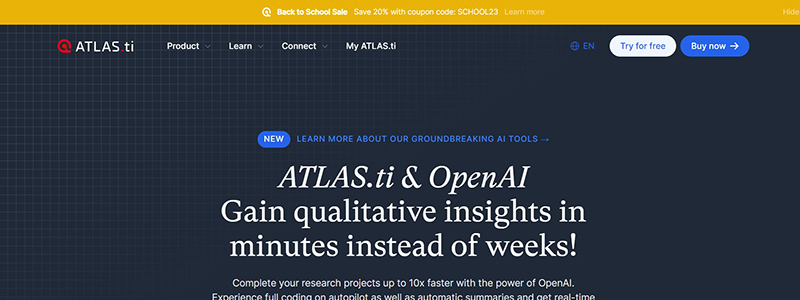
ATLAS.ti should be on your radar if you aim to become a master qualitative data analyst. Thought of as a pillar of the field, this software transcends simple data organization. It probes deeply and provides a strong framework to expose the several levels buried under textual, graphical, audio, even video data.
Main Attributes of ATLAS.ti:
- Coding System: Harness the ability of qualitative coding to classify and link many ideas. Perfect for legal researchers combing case law to find legal precedents.
- Visual Networking: Helps you to map the interactions between several data points. Essential for anthropologists charting social interactions inside a society.
- Multi-Format Support: From Word documents to audio files, ATLAS.ti supports a number of data formats, therefore enabling it to be flexible across many study fields.
- Query Builder: Customize and conduct sophisticated searches to find exactly what you need; this is essential for reporters looking at long-running stories.
Consider yourself an urban planner evaluating comments on a new public transportation project. Along with allowing you code important themes from focus group transcripts, ATLAS.ti enables you link these topics to certain demographic data—such as age or zip code—imported from surveys. Then, visualizing these insights via network views, use the query builder to tease out the particular issues of every demographic. This helps you to have a detailed knowledge that enables you to maximize the project in ways that appeal to various community demands.
ATLAS.ti converts data into a strategic advantage rather than merely analyzes it. The software lets you get to the core of your project faster by lowering the learning curve with a quite simple interface. ATLAS.ti is essentially a complete partner in your qualitative research efforts rather than only a software. For those seeking thorough, practical insights, ATLAS.ti is the keystone that will transform your research from instructive to illuminating.
MaxQDA Software
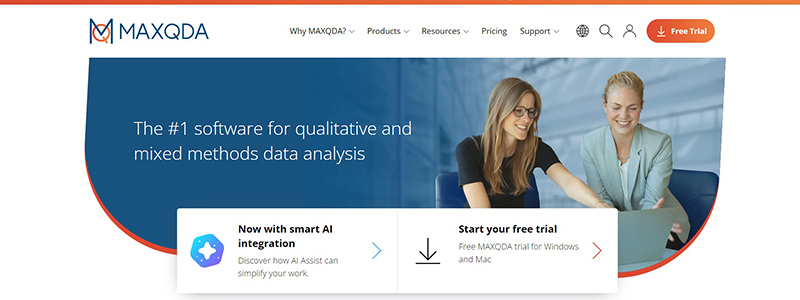
In the field of qualitative data analysis software, MaxQDA is a titan with a flexible toolbox that simplifies the complex task of breaking apart multifarious data. Unlike simple text-mining tools, MaxQDA uses one analytic umbrella to pull off a showstopper by letting you easily combine text, data, and multimedia materials.
Important characteristics unique to MaxQDA:
- Multi-Layer Coding: Annotate your data with several layers of codes. Imagine social scientists coding interviews to examine how socioeconomic level influences the nature of education.
- Sentiment Analysis: Helps one decode the emotional tone underlying textual data. For market researchers assessing consumer opinion from product reviews, this is quite helpful.
- Statistical Tools: Use statistical tools combining qualitative and quantitative approaches. Essential for health researchers wishing to match numerical clinical data with patient interviews is this software.
- Project Management: For academic academics juggling several datasets and deadlines, stay orderly with built-in planners and team collaboration tools.
Imagine a brand analyst sorting through mountains of social media entries to ascertain consumer opinion of a new line of environmentally friendly products. MaxQDA’s multi-layer coding lets the analyst monitor mentions of brand perception, product quality, and sustainability at once. Then the sentiment analysis software segments the posts into good, neutral, or negative groups. To create a complete brand health report, the analyst can then thread these strands together connecting numerical data like user engagement metrics with coded text parts.
MaxQDA is a strong engine driving your qualitative data analysis into a more relevant and useful shape, not only another software. MaxQDA breaks through the clutter with its easy-to-use interface so you may concentrate on what really counts—getting real insights that might influence policies and decisions. Simply said, MaxQDA is the workhorse you want near at hand if qualitative data analysis is your battleground.
Dedoose Software
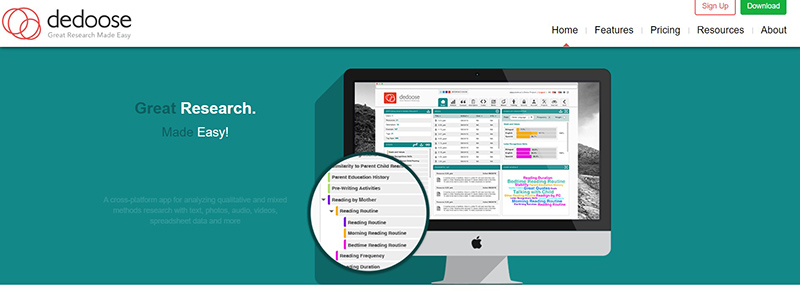
In the field of qualitative data analysis tools, dedoose is an unappreciated hero. Often eclipsed by more powerful rivals, this platform fights above its weight and offers a range of software meant for careful study of challenging data sets.
Dedoose’s eye-catching qualities include:
- Cloud-Based Operation: Access your data anytime, ideal for teams dispersed between time zones.
- Mixed-Methods Analysis: Often used in multi-disciplinary research projects, mixed-methods analysis deftly combines qualitative and quantitative data.
- Dynamic Visualizations: Create dynamic graphs and charts to give your data stories life.
- Time-tracking: Automatically records time spent on data analysis projects—ideal for initiatives with budgets.
Let’s dig in. Imagine an HR consultant has to analyze employee survey answers in order to enhance workplace environment. Dedoose intervenes so the consultant may combine quantifiable data such as employee retention rates with text-based input. The consultant can then convert this hybrid data into interesting, consumable graphs using its dynamic visuals that would start discussions among upper management. Furthermore, its cloud-based system allows a whole team, anywhere, to work on this research in real-time.
Dedoose provides the richness that seasoned researchers want for while yet breaking down the complexity of data analysis so that it is digestible for newbies. The time-tracking tool helps groups stay to budget limits and deadlines by adding still another degree of efficiency.
Whether your field of expertise is market research, consulting, or academics, Dedoose creates the red carpet welcoming you to enter a world of limitless data opportunities. It is a strong friend that transforms unprocessed data into useful insights, not only a tool. Dedoose opens a path for anyone looking for both simplicity and sophistication among the overcrowded data analysis software.
QDA Miner Software
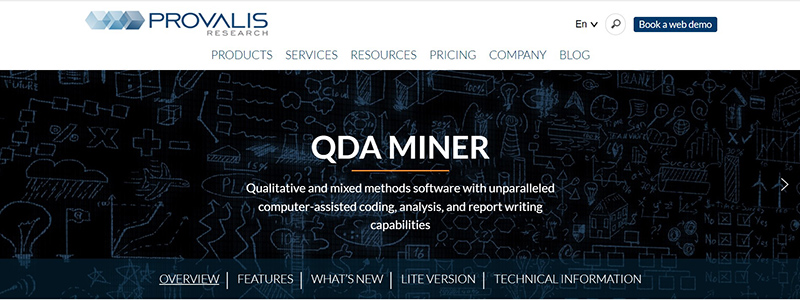
One qualitative data analysis gold mine is QDA Miner. Designed to provide you a modern experience, this software increases value extraction from non-numerical data by means of advanced tools Its features go beyond the traditional since they provide a sophisticated but easy-to-use interface that fits the challenging requirements of contemporary research.
Fundamental Characteristics of QDA Miner
- Text Retrieval: Zero focus on pertinent text fragments by easily flicking over large databases.
- Coding Flexibility: Tag your data with several coding choices spanning basic categories to more complex hierarchical systems.
- Data Import Support: To fill your analytical environment, drag and drop Excel files, drag and drop text, drag and drop photos.
- Analytic Reporting: Share interesting stories along with your results to create a whole picture.
Imagine a sociologist tracking political argument jargon. Their transcripts come in hundreds. Using QDA Miner’s text retrieval tool, they can quickly pluck out important phrases and keywords as they sweep over these papers like a hawk. The coding flexibility of the software lets them generate layered tags—identifying rhetorical devices, sentiment, and topic. When it comes time to show the results, the analytic reporting software kicks in to turn unorganized, uninteresting data into an interesting story.
At the junction of usability and power, QDA Miner sits. It redefines them rather than only cuts corners; it offers a strong yet adaptable platform that can manage everything you toss its way. Whether your field of work is market research, business analytics, or academics, this tool magnifies your capacity to spot trends, draw conclusions, and make data-driven judgments, so extending your intelligence. It establishes the benchmark for qualitative data analysis tools by demonstrating that refinement does not have to sacrifice accessibility.
QualCoder Software
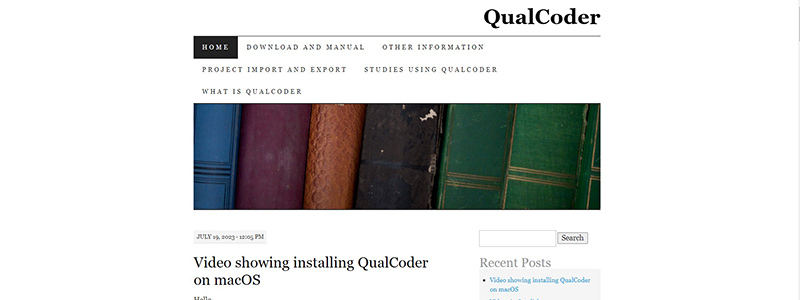
In qualitative data analysis, QualCoder is a model perfection. QualCoder removes the extraneous and focusses in on effective, consistent analysis in a digital terrain rich with sophisticated technologies that sometimes scare consumers. Anyone trying to negotiate the maze of textual or multimedia data will find this software rather helpful.
Principal Characteristics of QualCoder:
- User-Centric Interface: Customizable workspace that fit your particular demand.
- Effortless Coding: Drag and drop capabilities of easy coding help to simplify data tagging’s menial work.
- Text and Media Support: deftly include audio and video data into your works alongside text.
- Multi-Project Management: Is the supervision of several activities without ever losing concentration or effectiveness.
Consider an HR consultant looking into organizational culture. They will sort through hundreds of questionnaires, interviews, even videotaped exchanges. QualCoder lets users import all these many data kinds into one integrated platform, therefore streamlining this effort. They can then quickly apply codes to identify pertinent material—be it a sentence in an interview transcript that suggests employee discontent, or a bit of a recorded meeting exposing managerial attitudes.
This instrument offers a starting point for exact and insightful study. QualCoder achieves the reverse whereas many solutions trip over their ambition and provide bloated features that compromise your workflow. It stays laser-focused on enhancing your A through Z qualitative data analysis. QualCoder has characteristics that streamline difficult tasks to surpass qualitative data software standards. While keeping the great degree of accuracy professionals need, it simplifies the whole analytical process, from first data collecting to final reporting. QualCoder is your first choice if you want to uncover the most profound understanding from your data.
HyperRESEARCH Software

Striking a mix between user-friendliness and strong capabilities, HyperRESEARCH provides an unmatched qualitative data analysis experience. In a time when data drives most decisions, this software creates a special place by streamlining difficult work for inexperienced as well as experienced researchers.
HyperRESEARCH’s special selling propositions:
- Cross-Platform Utility: Runs easily on Mac and Windows platforms.
- Code Management: Expansive but simple code choices to tag, track, and evaluate each data point.
- Multi-Data Formats: Incorporate text, audio, video, and even spreadsheets for a thorough analytical range.
- Dynamic Reporting: Provides strong textual and graphic reports to help you break up your study into consumable terms.
Consider yourself a medical researcher attempting to evaluate patient satisfaction among several therapies. You compile numerical statistics on recovery rates, textual reviews, and video quotes. HyperRESEARCH helps you to organize all this material under one roof. You can link it all back to hard figures, tag terms in reviews that imply happiness or discontent, highlight passages of video interviews that tell volumes, and so on.
HyperRESEARCH provides a toolkit as large as it is accessible, therefore augmenting your efforts at qualitative data analysis. It frees you to zone in on analysis that tells a rich, multifarious story—rich, multifarious, and supported by data—by removing boring manual chores. From coding to categorization, from pattern detection to final reporting, this software is a one-stop shop for all your qualitative data analysis needs. Designed to help rather than complicate, HyperRESEARCH transforms qualitative analysis from a struggle with tools into an arrival at practical insights. HyperRESEARCH is the cornerstone for qualitative excellence for researchers seeking unmatched depth and breadth in their data-driven activities.
TAMS Analyzer Software
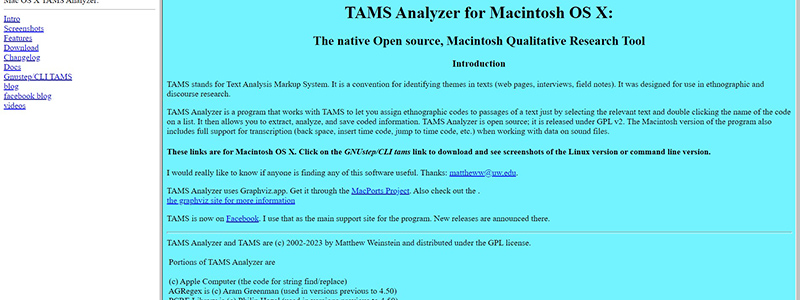
With TAMS Analyzer, a strong tool meant to propel your analysis into new levels of depth and specificity, unlock the possibilities of your qualitative data. When handling different kinds of qualitative data—text documents, transcripts, or other sources—you want software that will simplify your workflow without compromising the integrity of your research.
Why Is TAMS Analyzer Unique?
- Ease of Use: Simple, direct stages with intuitive design help you to negotiate difficult jobs.
- Cost-effective: provides a striking array of capabilities without straying your means.
- Mac Compatibility: Designed largely for Mac users, this software easily connects with your current setup.
- Text Parsing and Coding: Advanced tools for text parsing and coding provide in-depth tagging and categorization, therefore helping me to mine through material.
Assume for the moment you are in educational research looking at how distant learning affects student involvement. You have compiled a lot of written comments, web forums, and interviews. Once you quickly code repeating themes like “disengagement,” “zoom fatigue,” or “active participation,” TAMS Analyzer lets you cross-reference them with other data sources, including student grades or attendance records.
TAMS Analyzer aims to simplify your life while other systems can bog you down with complex features. By automating monotonous operations, it relieves some of your responsibility and frees you to delve deeply into data analysis. Whether you’re compiling data from several sources or focusing on minute text details, the program’s flexible interface readily fits the type of your job. It’s a tool that develops with your research requirements and can handle ever complex projects while keeping simplicity of usage. For researchers dedicated to unmatched qualitative analysis, TAMS Analyzer offers an amazing mix of cost and capability.
Quirkos Software
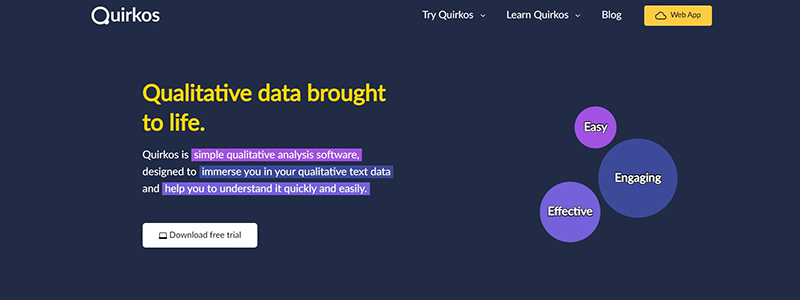
Here is your one-stop shop for all things qualitative data and analysis: Quirkos. Using this innovative software allows you to use real-time analytics to transform unprocessed data into relevant insights. Say goodbye to conventional wisdom that wastes time and money; Quirkos provides a complete toolkit that makes qualitative research not only doable but also very fun.
Characteristics Unique to Quirkos:
- Visual Interface: Quirkos offers an amazing dynamic interface that helps data handling seem more like an art form than a labor.
- Multi-Source Import: Easily import text from PDFs, Word documents, or transcripts.
- Custom Codebooks: That exactly corresponds with your research emphasis.
- Real-Time Collaboration: Share your project in real-time to team members and stakeholders thereby creating a symbiotic atmosphere for data analysis.
Consider yourself a healthcare analyst looking at patient satisfaction in several treatment environments. Quirkos allows you import focus group transcripts, survey answers, and even web reviews. Once your data is in, Quirkos lets the analytical floodgates open. Tag terms on staff contact, waiting times, or treatment efficacy. Link them to patient demographics or treatment outcomes to provide a comprehensive, multi-layered study that may guide daily operations as well as policy.
Unmatched is the versatility Quirkos provides. Without becoming caught in a web of complexity, you can turn between themes, mix codes, and even go backtracking. This software lets you surpass simple surface-level understanding. You will explore the subtleties, spot developing trends, and even find patterns you never would have considered looking for. Timestensitive? Relax; Quirkos speeds up your job without sacrificing depth or quality.
For the single academic as much as for large research teams, Quirkos offers a scalable platform. For anyone committed to raising their qualitative analysis to a new degree of perfection, it is the best tool available.
Raven’s Eye Software
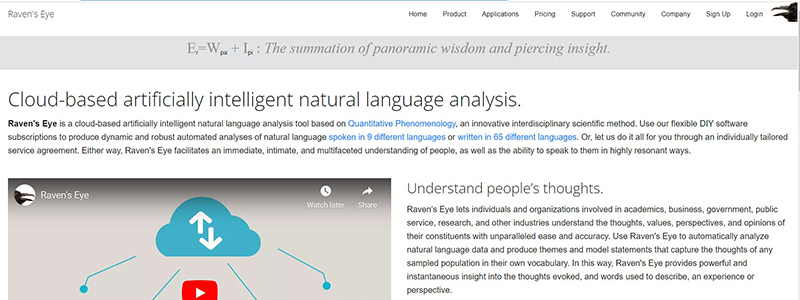
Now enter Raven’s Eye, a toolkit for individuals doing qualitative data analysis. The platform probes deeply rather than only skimming the surface and reveals nuggets of ideas that might advance your work. The revolutionary software meant to hone your qualitative research is Raven’s Eye, which helps you to simplify and analyze the rich and complex universe of text data.
Amazing qualities of Raven’s Eye:
- Natural Language Quantification: Count on this tool to turn unprocessed text into useful statistics in seconds.
- Automated Coding:Say goodbye to labor-intensive, manual tasks; let Raven’s Eye do things for you automatically.
- Cross-language abilities: Why restrict yourself? Explore data easily in several languages.
- Data Security: Top-notch encryption techniques help you to protect your valuable research data.
Imagine yourself as a consumer behavior analyst deeply immersed in internet reviews of a just introduced smartphone. To start with, the raw data is deluging. Start Raven’s Eye and see it sort hundreds of thousands of reviews in minutes to separate wheat from chaff. What do users especially praise about? Features irritate them? Have straight at your hands granular data right now. Sort emotions, cross-reference them with characteristics, and create a whole picture that might guide the next version of a product.
Beyond the obvious measurements, Raven’s Eye lets you break out the minutiae—interpret frequency, relevance, even cultural subtleties that hand study might miss. This software will provide precisely sharp analysis, therefore opening the path for educated decision-making.
Raven’s Eye provides a surgical means of qualitative analysis in the era of big data. By reducing the difficult and streamlining the unmanageable, this tool helps academics, businesspeople, and data scientists understand qualitative data.
Transana Software
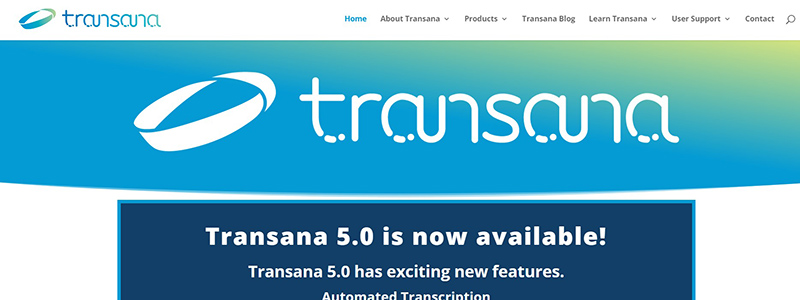
Welcome to Transana, your one-stop source for in-depth qualitative data analysis—innovation. This powerhouse software explores multimedia materials to create strong, practical insights rather than just interprets words.
Transana differs in these ways:
- Perfect for both textual and multimedia data, multi-method analysis lets many research strategies be used.
- Without compromising data integrity, carefully pool resources and ideas with team members in a collaborative workspace.
- For a microscopic perspective, break up massive data sets into reasonable, analyzable chunks.
- Use an easy, graphic chronology to negotiate the turns in your data terrain.
Consider yourself a healthcare analyst gathering data on patient-doctor contacts. Among your raw materials are typed transcriptions, handwritten notes, andvideointerviews.Transanaintervenestohelpto streamline this mountains of mixed-method data. The software maps out frequent patterns of particular terms or phrases used in these encounters, easily classifies each video clip, links them with pertinent annotations. The result is Driven into the core emotions, pain issues, and even possible discoveries, a rich tapestry of ideas beyond what the eye sees or the ear hears.
Transana helps you to break out complexity and go right to the roots. The strong features of the software guarantee that you are not only passing through. Rather, you are creating paths through the maze of qualitative data, extracting ideas that might direct policy, change perceptions, or inspire a discovery in your field of work.
Choose Transana when generic tools won’t be sufficient. Whether your work is academician, market researcher, or documentary filmmaker, Transana offers the subtle, layered analysis that qualitative data calls for, therefore improving your work from good to outstanding.
In essence
Oh, that is an extensive keyword list! Try to condense that into a cogent, 200-word conclusion for your paper on the top qualitative data analysis tools.
Selecting the appropriate qualitative data analysis software among a sea of choices might prove difficult. Our thorough investigation attempts to streamline your decision-making process. Offering the top 12 solutions that have shown their value in an ever-changing digital scene, we have sorted via consumer ratings, pricing points, and features including integration capabilities and UX design.
There is a software to fit your circumstances regardless of your level of experience as a manager or just starting your data collecting journey. From strong SQL databases to user-friendly tools like Provalis, we have addressed a wide spectrum. ERP and CRM features may appeal to individuals trying to oversee a more complicated ecosystem. Agile-loving companies might choose low-code or even no-code systems, which provide quick and customisable data analysis.
So ready to choose wisely? Don’t miss out on Plerdy products; our best advice for people dedicated to optimizing the possibilities of their data is Providing a free trial and open pricing, Plerdy offers priceless information for visitor tracking, e-commerce enhancement, and much more. Time to start jumping in and elevate your analytics game—subscribed today to view your data from a whole new perspective.
This ending should satisfy your needs and naturally incorporate as many keywords as feasible!
